-
 Katsukawa Shun'ei (勝川 春英; 1762 – 1819).TITLE: Sawamura Sôjûrô III as Kakogawa Honzô.SERIES: Kanadehon Chūshingura (Kana practice book: Treasury of the loyal retainers").DATE: 1795Signed: Shun'ei ga (春英画). Publisher: Iwatoya Kisaburō, Marks 173/p.169. Vertical Ōban: 14.75 x 9.625 inchOn 4th lunar month of 1795 Sôjûrô plays the roles of En'ya Hangan and Kakogawa Honzô in the drama "Kanadehon Chûshingura" at Miyakoza theater in Edo.
Katsukawa Shun'ei (勝川 春英; 1762 – 1819).TITLE: Sawamura Sôjûrô III as Kakogawa Honzô.SERIES: Kanadehon Chūshingura (Kana practice book: Treasury of the loyal retainers").DATE: 1795Signed: Shun'ei ga (春英画). Publisher: Iwatoya Kisaburō, Marks 173/p.169. Vertical Ōban: 14.75 x 9.625 inchOn 4th lunar month of 1795 Sôjûrô plays the roles of En'ya Hangan and Kakogawa Honzô in the drama "Kanadehon Chûshingura" at Miyakoza theater in Edo. -

Small iron tsuba (tantō size) of aoi form with the design of paulownia leaves and blossoms in copper and brass flat inlay (hira-zōgan). Brass sekigane. Open kozuka hitsu-ana.
Early Edo period, 17th century.
Size: 53.4 x 40.7 x 4.4 mm; weight: 47.4 g
-
 Artist: Utagawa Kuniyoshi [歌川 國芳] (Japanese, 1798 – 1861). Publisher: Enshuya Matabei [遠州屋又兵衛] (Japanese, fl. c. 178 – 1881) – no seal, ref: Kunisada Project. Title: A Summer Evening [夏乃夕暮] (Natsu no Yūgure). A young woman in purple kimono decorated with cranes and waves catching a firefly among yellow and purple flowers. Signed: Ichiyosai Kuniyoshi ga [一勇斎 国芳 画] in a red cartouche and sealed with paulownia (kiri mon). Date seal and double nanushi censor seals: Fuku & Muramatsu, 1853 (Kaei 6, 2nd month). No publisher's seal. Size: Uchiwa-e (untrimmed fan print) 228 x 296 mm. The yellow flower is probably Patrinia scabiosifolia (ominaeshi) [女郎花]. The purple flower seems to be Platycodon grandiflorus or Balloon Flower (kikyō) [桔梗]. Besides, there are visible panicles of Miscanthus sinensis, or Japanese pampas grass (susuki) [薄]. These three are part of the Seven Grasses of Autumn (aki no nanakusa) [秋の七草].
Artist: Utagawa Kuniyoshi [歌川 國芳] (Japanese, 1798 – 1861). Publisher: Enshuya Matabei [遠州屋又兵衛] (Japanese, fl. c. 178 – 1881) – no seal, ref: Kunisada Project. Title: A Summer Evening [夏乃夕暮] (Natsu no Yūgure). A young woman in purple kimono decorated with cranes and waves catching a firefly among yellow and purple flowers. Signed: Ichiyosai Kuniyoshi ga [一勇斎 国芳 画] in a red cartouche and sealed with paulownia (kiri mon). Date seal and double nanushi censor seals: Fuku & Muramatsu, 1853 (Kaei 6, 2nd month). No publisher's seal. Size: Uchiwa-e (untrimmed fan print) 228 x 296 mm. The yellow flower is probably Patrinia scabiosifolia (ominaeshi) [女郎花]. The purple flower seems to be Platycodon grandiflorus or Balloon Flower (kikyō) [桔梗]. Besides, there are visible panicles of Miscanthus sinensis, or Japanese pampas grass (susuki) [薄]. These three are part of the Seven Grasses of Autumn (aki no nanakusa) [秋の七草]. -
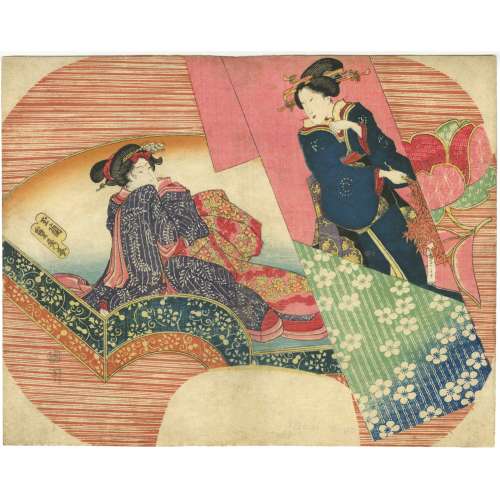 Artist: Utagawa Sadahide [歌川貞秀] (Japanese, 1807 – 1879). Publisher: Kojimaya Jūbei [小島屋重兵衛] (Japanese, c. 1797 – 1869); seal: Marks #264, p. 210) Signed: Gyokuransai Sadahide ga [玉蘭斎貞秀 画]. Date seal: 1830 (Bunsei 13 / Tenpō 1). Size: Uncut fan print (uchiwa-e); 229 x 292 mm
Artist: Utagawa Sadahide [歌川貞秀] (Japanese, 1807 – 1879). Publisher: Kojimaya Jūbei [小島屋重兵衛] (Japanese, c. 1797 – 1869); seal: Marks #264, p. 210) Signed: Gyokuransai Sadahide ga [玉蘭斎貞秀 画]. Date seal: 1830 (Bunsei 13 / Tenpō 1). Size: Uncut fan print (uchiwa-e); 229 x 292 mm -
 Artist: Utagawa Kunisada [歌川 国貞] a.k.a. Utagawa Toyokuni III [三代歌川豊国] (Japanese, 1786 – 1865). Block cutter: Yokokawa Takejirō [横川竹二郎] (Japanese, fl. 1845 – 1863), seal Hori Take [彫竹]. Publisher: Ibaya Senzaburō [伊場屋仙三郎] (Japanese, fl. C. 1845 – 1847). Title: Book of an incoming ship [入船帳] (Irifune-chō). Series: Comparison of Eight Books of Proficiency and Eloquence [口も手も美立八帳] (Kuchimo temo mitate hatchō). Date seal and aratame censor seal: 1856 (Ansei 3). Signed: Toyokuni ga in toshidama cartouche. Media: Untrimmed fan print (uchiwa-e), 231 x 300 mm. Provenance: The Collection of Paul F. Walter, Christie's, New York, 2017, lot 341; sold together with 5 other fan prints for $25,000. Before: Israel Goldman, Japanese Prints, Catalogue 11, 2005, no. 37. Ref: [LIB-1693.2018] The Collection of Paul Walter. — NY: Christie's, 2017, p. 363. Ref: Israel Goldman, Catalogue 2018, № 51: "Utagawa Kunisada (1786-1865) A Beauty Seated in a Boat. From the series Mitate hatcho (A Parody of Eight Books). 1856. Fan print. 23.3 x 30 cm. Provenance: Israel Goldman, Japanese Prints, Catalogue 11, 2005, no. 37, The Collection of Paul F. Walter, Christie's, New York, 2017, lot 341. Fine impression, colour and condition. The title contains the saying: “Kuchi mo hatcho te mo hatcho (As quick with one’s hand as one’s tongue)." Special thanks to Horst Graebner for the detailed description.
Artist: Utagawa Kunisada [歌川 国貞] a.k.a. Utagawa Toyokuni III [三代歌川豊国] (Japanese, 1786 – 1865). Block cutter: Yokokawa Takejirō [横川竹二郎] (Japanese, fl. 1845 – 1863), seal Hori Take [彫竹]. Publisher: Ibaya Senzaburō [伊場屋仙三郎] (Japanese, fl. C. 1845 – 1847). Title: Book of an incoming ship [入船帳] (Irifune-chō). Series: Comparison of Eight Books of Proficiency and Eloquence [口も手も美立八帳] (Kuchimo temo mitate hatchō). Date seal and aratame censor seal: 1856 (Ansei 3). Signed: Toyokuni ga in toshidama cartouche. Media: Untrimmed fan print (uchiwa-e), 231 x 300 mm. Provenance: The Collection of Paul F. Walter, Christie's, New York, 2017, lot 341; sold together with 5 other fan prints for $25,000. Before: Israel Goldman, Japanese Prints, Catalogue 11, 2005, no. 37. Ref: [LIB-1693.2018] The Collection of Paul Walter. — NY: Christie's, 2017, p. 363. Ref: Israel Goldman, Catalogue 2018, № 51: "Utagawa Kunisada (1786-1865) A Beauty Seated in a Boat. From the series Mitate hatcho (A Parody of Eight Books). 1856. Fan print. 23.3 x 30 cm. Provenance: Israel Goldman, Japanese Prints, Catalogue 11, 2005, no. 37, The Collection of Paul F. Walter, Christie's, New York, 2017, lot 341. Fine impression, colour and condition. The title contains the saying: “Kuchi mo hatcho te mo hatcho (As quick with one’s hand as one’s tongue)." Special thanks to Horst Graebner for the detailed description. -
 Artist: Toyohara Chikanobu [豊原周延] (Japanese, 1838 – 1912) Signed: Chikanobu hitsu [周延筆] Publisher: [ 東京掘江町] Tokyo Horiemachi | [えん市製] Enshi-sei. Media: Fan print (uchiwa-e, 団扇絵), 192 x 172 mm. Possibly Iwai Kumesaburō IV [岩井粂三郎] (1856 – 1886) a.k.a. Iwai Hisajirō III [岩井久次郎] in the role of Ono no Komachi [小野乃小町] and Nakamura Shikan IV [中村芝翫] in the role of Kisen Hōshi [喜せん法師]. Play: The Six Immortal Poets in Colorful Guises [六歌仙体綵] (Rokkasen Sugata no irodori). Inscription: Left: Kisen [喜せん] | Shikan [芝翫] Right: Komachi [小町] | Kumesaburō [粂三郎]. Actors: Iwai Kumesaburō IV [岩井粂三郎] (1856 – 1886) a.k.a. Iwai Hisajirō III [岩井久次郎]. Nakamura Shikan IV [中村芝翫] (Japanese, 1831 – 1899); other names: Nakamura Fukusuke I [中村福助], Nakamura Masanosuke I, Nakamura Komasaburō, Nakamura Tamatarō I.
Artist: Toyohara Chikanobu [豊原周延] (Japanese, 1838 – 1912) Signed: Chikanobu hitsu [周延筆] Publisher: [ 東京掘江町] Tokyo Horiemachi | [えん市製] Enshi-sei. Media: Fan print (uchiwa-e, 団扇絵), 192 x 172 mm. Possibly Iwai Kumesaburō IV [岩井粂三郎] (1856 – 1886) a.k.a. Iwai Hisajirō III [岩井久次郎] in the role of Ono no Komachi [小野乃小町] and Nakamura Shikan IV [中村芝翫] in the role of Kisen Hōshi [喜せん法師]. Play: The Six Immortal Poets in Colorful Guises [六歌仙体綵] (Rokkasen Sugata no irodori). Inscription: Left: Kisen [喜せん] | Shikan [芝翫] Right: Komachi [小町] | Kumesaburō [粂三郎]. Actors: Iwai Kumesaburō IV [岩井粂三郎] (1856 – 1886) a.k.a. Iwai Hisajirō III [岩井久次郎]. Nakamura Shikan IV [中村芝翫] (Japanese, 1831 – 1899); other names: Nakamura Fukusuke I [中村福助], Nakamura Masanosuke I, Nakamura Komasaburō, Nakamura Tamatarō I. -
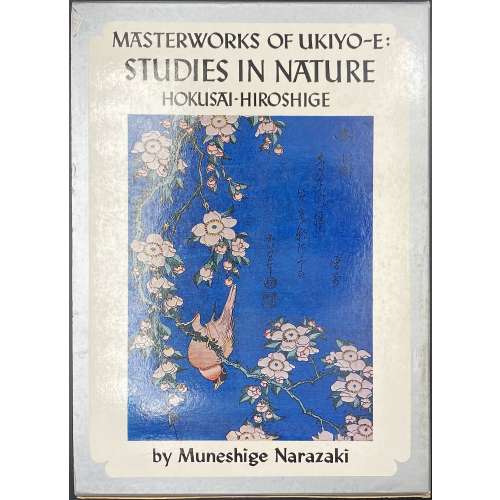 Hardcover volume from the series Masterworks of ukiyo-e, 26.3 x 19.2 cm, bound in unprimed canvas, red characters on black strip to front, red and black lettering to spine, tan flat endpapers, in a pictorial slipcase with series design (black lettering on silver spine); pp: [1-6]: h.t./frontis. (colour plate pasted in), t.p./imprint, contents/acknowledgements), 7-31 text, [32] blank, 33-96 (58 plates w/captions). Title-page (in frame): MASTERWORKS OF UKIYO-E | STUDIES IN NATURE | HOKUSAI-HIROSHIGE | by Muneshige Narazaki | Translated by John Bester | {publisher’s device} | KODANSHA INTERNATIONAL LTD. | Tokyo, Japan & Palo-Alto, Calif., U.S.A | {vertical, between rules 花鳥風月} || 花鳥風月 (Kachou Fugetsu) – beauties of nature. Series: Masterworks of ukiyo-e, № 11. Contributors: Muneshige Narazaki [楢崎 宗重] (Japanese, 1904 – 2001) – author. John Bester (British, 1927 – 2010) – translator. Katsushika Hokusai [葛飾 北斎] (Japanese, 1760 – 1849) – artist. Utagawa Hiroshige [歌川 広重] a.k.a. Andō Hiroshige [安藤 広重] (Japanese, 1797 – 1858) – artist.
Hardcover volume from the series Masterworks of ukiyo-e, 26.3 x 19.2 cm, bound in unprimed canvas, red characters on black strip to front, red and black lettering to spine, tan flat endpapers, in a pictorial slipcase with series design (black lettering on silver spine); pp: [1-6]: h.t./frontis. (colour plate pasted in), t.p./imprint, contents/acknowledgements), 7-31 text, [32] blank, 33-96 (58 plates w/captions). Title-page (in frame): MASTERWORKS OF UKIYO-E | STUDIES IN NATURE | HOKUSAI-HIROSHIGE | by Muneshige Narazaki | Translated by John Bester | {publisher’s device} | KODANSHA INTERNATIONAL LTD. | Tokyo, Japan & Palo-Alto, Calif., U.S.A | {vertical, between rules 花鳥風月} || 花鳥風月 (Kachou Fugetsu) – beauties of nature. Series: Masterworks of ukiyo-e, № 11. Contributors: Muneshige Narazaki [楢崎 宗重] (Japanese, 1904 – 2001) – author. John Bester (British, 1927 – 2010) – translator. Katsushika Hokusai [葛飾 北斎] (Japanese, 1760 – 1849) – artist. Utagawa Hiroshige [歌川 広重] a.k.a. Andō Hiroshige [安藤 広重] (Japanese, 1797 – 1858) – artist. -
 Iron tsuba of quatrefoil form with design of bamboo stems and leaves, and a plank bridge in openwork (sukashi). Hitsu-ana of irregular form. Iron with smooth chocolate patina. Copper and shakudō sekigane. This piece is illustrated in Sasano: Japanese Sword Guard Masterpieces from the Sasano Collection, 1994 on page 295 under № 254 with the following description:
Iron tsuba of quatrefoil form with design of bamboo stems and leaves, and a plank bridge in openwork (sukashi). Hitsu-ana of irregular form. Iron with smooth chocolate patina. Copper and shakudō sekigane. This piece is illustrated in Sasano: Japanese Sword Guard Masterpieces from the Sasano Collection, 1994 on page 295 under № 254 with the following description:Nishigaki. First generation Kanshiro (died in the sixth year of Genroku, 1693, at the age of 81). Sukashi design: Bamboo (take). Early Edo period, late 17th century (Kanbun / Enppo era). Height: 72.6 mm; Width: 71.5 mm; Rim thickness: .6 mm; Centre thickness: 5.1 mm. Rounded rim. The shape of this sword guard is a quatrefoil and the design is arranged in the form of a saddle flap. Two bamboo trunks with leaves comprise the design. Calm, soothing and sophisticated are the features of this artist in his later years. Such characteristics may remind one of the work of the first Hikozo.
Provenance: Sasano Masayuki collection, № 254. What is interesting, and what had been found by Bruce Kirkpatrick, is that in the earlier photograph of the same piece ['Sukashi tsuba - bushido no bi' by Sasano Masayuki, photography by Fujimoto Shihara, 1972 (in Japanese), page 245, №201] we clearly see kebori - linear carving that decorates the bamboo leaves and the planks of the bridge. The said kebori have totally disappeared between 1972 and 1994. The tsuba became absolutely flat! Now we can only speculate about the reasons for such cruel treatment of the artistically and historically important item.
Sukashi tsuba - bushido no bi. Author: Sasano Masayuki, photography: Fujimoto Shihara, 1972 (in Japanese). Page 245, №201.
-
 Utagawa Toyokuni (歌川豐國); 1769 – 24 February 1825. The kabuki actors Ichikawa Danzo IV as Jiroemon (in draw cape) and Morita Kanya VIII as Buemon. Play 'Oriai Tsuzure no Nishiki', performed at the Moritaza Theater in the 7th month of 1798. Publisher: Eijudo.
Utagawa Toyokuni (歌川豐國); 1769 – 24 February 1825. The kabuki actors Ichikawa Danzo IV as Jiroemon (in draw cape) and Morita Kanya VIII as Buemon. Play 'Oriai Tsuzure no Nishiki', performed at the Moritaza Theater in the 7th month of 1798. Publisher: Eijudo. -
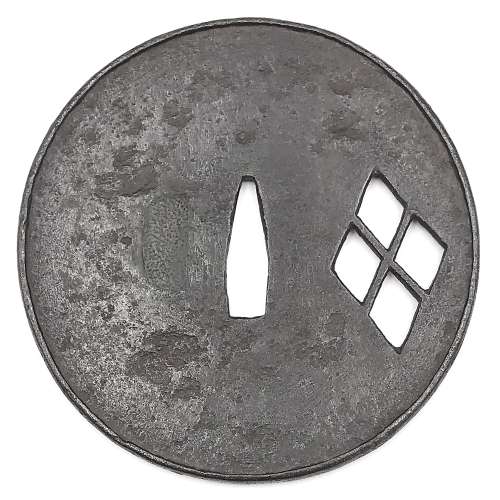 Iron tsuba of round form with design of diamond-shaped family crest (waribishi-mon) in openwork (sukashi). Bevelled, raised rim. Kozuka-hitsu-ana plugged with tin or lead. Ko-Katchushi school. Early Muromachi period: Early 15th century (Oei era). Size: Height: 89.3 mm. Width: 89.0 mm. Rim thickness: 4.3 mm. Center thickness: 2.9 mm. Provenance: Sasano Masayuki Collection, № 41: "In this tsuba, a family crest incorporating four lozenges sits upright on the right side of the nakago-ana. The straight lines of the lozenge add substance and power. Initially, the crest creates confusion regarding the age, yet the overall impression is one lacking in vigor and probably dates rather later than Nanbokucho period".
Iron tsuba of round form with design of diamond-shaped family crest (waribishi-mon) in openwork (sukashi). Bevelled, raised rim. Kozuka-hitsu-ana plugged with tin or lead. Ko-Katchushi school. Early Muromachi period: Early 15th century (Oei era). Size: Height: 89.3 mm. Width: 89.0 mm. Rim thickness: 4.3 mm. Center thickness: 2.9 mm. Provenance: Sasano Masayuki Collection, № 41: "In this tsuba, a family crest incorporating four lozenges sits upright on the right side of the nakago-ana. The straight lines of the lozenge add substance and power. Initially, the crest creates confusion regarding the age, yet the overall impression is one lacking in vigor and probably dates rather later than Nanbokucho period". -
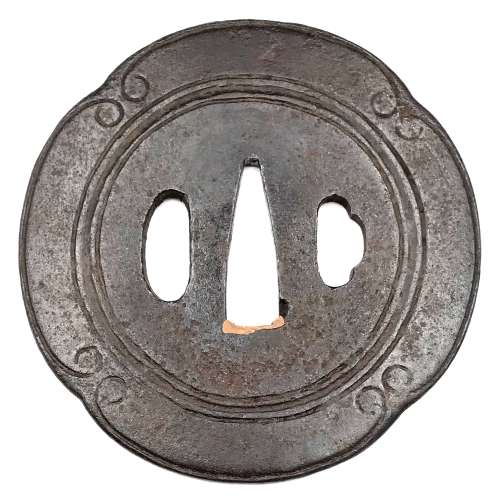 The thin, four-lobed iron plate of brownish color is carved on each side with two concentric grooves in the middle of the web, and with four thin scroll lines (handles, kan) that follow the shape of the rim. The hitsu-ana were added at a later date. Copper sekigane. Kamakura-bori school. Muromachi period, circa 1400-1550. Size: Height 80.4 mm, width 79.0 mm, thickness 3.2 mm at seppa-dai and 2.7 mm at the rim. Weight: 97.7 g. NBTHK Certificate №4004241: 'Hozon' attestation. As for the motif: the concentric circles is a widespread and generic design. It is described by John W. Dower [The Elements of Japanese Design, 1985, p. 132, #2201-30] as follows: Circle: Enclosure (wa). As a crest by itself, the cirlce carries obvious connotations of perfection, harmony, completeness, integrity, even peace. [...] Ordinary circles are labeled according to their thickness, with terminology ranging from hairline to "snake's eye". The motif that is described by both Compton Collection and R.E. Haynes as "scrolls", presented by John W. Dower as "Handle (kan): Although probably a purely ornamental and nonrepresentational design in origin, over the centuries this motif acquired the label kan, denoting its resemblance to the metal handles traditionally used on chests of drawers. [...] Very possibly the "handle" motif represents an early abstract version of the popular mokko, or melon pattern." Early Chinese Taoists claimed that special melon was associated with the Eastern Paradise of Mount Horai just as life-giving peaches were associated with the Western Paradise of the Kunlun Mountains. [...] A design motif called mokko (also translated as "melon" in accordance with the two ideographs with which it is written) may have nothing to do with the fruit. Mokko designs... are widely used as crests of both private families and Shinto shrines and are repeated as background designs that evoke a sense of classicism" [Symbols of Japan. Merrily Baird, 2001]. There is a look alike tsuba at Dr. Walter A. Compton Collection, 1992, Christie’s auction, Part II, pp. 14-15, №16:
The thin, four-lobed iron plate of brownish color is carved on each side with two concentric grooves in the middle of the web, and with four thin scroll lines (handles, kan) that follow the shape of the rim. The hitsu-ana were added at a later date. Copper sekigane. Kamakura-bori school. Muromachi period, circa 1400-1550. Size: Height 80.4 mm, width 79.0 mm, thickness 3.2 mm at seppa-dai and 2.7 mm at the rim. Weight: 97.7 g. NBTHK Certificate №4004241: 'Hozon' attestation. As for the motif: the concentric circles is a widespread and generic design. It is described by John W. Dower [The Elements of Japanese Design, 1985, p. 132, #2201-30] as follows: Circle: Enclosure (wa). As a crest by itself, the cirlce carries obvious connotations of perfection, harmony, completeness, integrity, even peace. [...] Ordinary circles are labeled according to their thickness, with terminology ranging from hairline to "snake's eye". The motif that is described by both Compton Collection and R.E. Haynes as "scrolls", presented by John W. Dower as "Handle (kan): Although probably a purely ornamental and nonrepresentational design in origin, over the centuries this motif acquired the label kan, denoting its resemblance to the metal handles traditionally used on chests of drawers. [...] Very possibly the "handle" motif represents an early abstract version of the popular mokko, or melon pattern." Early Chinese Taoists claimed that special melon was associated with the Eastern Paradise of Mount Horai just as life-giving peaches were associated with the Western Paradise of the Kunlun Mountains. [...] A design motif called mokko (also translated as "melon" in accordance with the two ideographs with which it is written) may have nothing to do with the fruit. Mokko designs... are widely used as crests of both private families and Shinto shrines and are repeated as background designs that evoke a sense of classicism" [Symbols of Japan. Merrily Baird, 2001]. There is a look alike tsuba at Dr. Walter A. Compton Collection, 1992, Christie’s auction, Part II, pp. 14-15, №16: The description goes: “A kamakurabori type tsuba, Muromachi period, circa 1400. The thin, six-lobed iron plate is carved on each side with a wide groove that follows the shape of the rim, and with six scroll lines and a single thin circular groove. […] The hitsu-ana was added at a later date, circa 1500-1550. Height 8.3 cm, width 8.6 cm, thickness 2.5 mm. The tsuba was initially intended to be mounted on a tachi of the battle type in use from Nambokucho to early Muromachi period (1333-1400)”. Sold at $935.
And another one in Robert E. Haynes Catalog #9 on page 24-25 under №23:
The description goes: “A kamakurabori type tsuba, Muromachi period, circa 1400. The thin, six-lobed iron plate is carved on each side with a wide groove that follows the shape of the rim, and with six scroll lines and a single thin circular groove. […] The hitsu-ana was added at a later date, circa 1500-1550. Height 8.3 cm, width 8.6 cm, thickness 2.5 mm. The tsuba was initially intended to be mounted on a tachi of the battle type in use from Nambokucho to early Muromachi period (1333-1400)”. Sold at $935.
And another one in Robert E. Haynes Catalog #9 on page 24-25 under №23:
 R.E. Haynes description: “Typical later Kamakura-bori style work. This type of plate and carving show the uniform work produced by several schools in the Muromachi period. Some had brass inlay and others were just carved as this one is. The hitsu are later. Ca. 1550. Ht. 8.8 cm, Th. 3.25 mm”. Sold for $175.
R.E. Haynes description: “Typical later Kamakura-bori style work. This type of plate and carving show the uniform work produced by several schools in the Muromachi period. Some had brass inlay and others were just carved as this one is. The hitsu are later. Ca. 1550. Ht. 8.8 cm, Th. 3.25 mm”. Sold for $175.
-
 A circular iron tsuba with a design of three monkey toys (kukurizaru) in small openwork (ko-sukashi); the plate further decorated with four rows of brass dot inlay (ten-zogan). The center of the plate and the openings are outlined with brass wire. Copper sekigane. A few dots missing. Muromachi period. Dimensions: 89.0 x 88.2 x 2.9 mm. Kukurizaru was an often used motif on old tsuba. The symbol has two explanations: (1) "upright" monkey, a sort of roly-poly toy, alludes to 'never-ever give up' property of the samurai; (2) monkeys are represented with their hands and feet tied to their back to symbolize self-control. Other examples of the same design:
A circular iron tsuba with a design of three monkey toys (kukurizaru) in small openwork (ko-sukashi); the plate further decorated with four rows of brass dot inlay (ten-zogan). The center of the plate and the openings are outlined with brass wire. Copper sekigane. A few dots missing. Muromachi period. Dimensions: 89.0 x 88.2 x 2.9 mm. Kukurizaru was an often used motif on old tsuba. The symbol has two explanations: (1) "upright" monkey, a sort of roly-poly toy, alludes to 'never-ever give up' property of the samurai; (2) monkeys are represented with their hands and feet tied to their back to symbolize self-control. Other examples of the same design:
The Henry D. Rosin Collection №9.

Lundgren Collection №7.
-

Iron tsuba of circular form with the knotted geese (kari) flying over the rough waves pierced (sukashi) and carved in low relief (nikubori). Hitsu-ana plugged with soft metal. Hitsu-ana plugged with soft metal (tin or lead).
Signed: Echizen koku jū Myochin Katsuharu saku.
Edo period.Size: Height: 80.7 mm; Width: 81.0 mm; Thickness: 4.5 mm; Weight: 110 g.
Two tsuba of this master can be found at Georg Oeder Collection (Japanische Stichblätter und Schwertzieraten. Sammlung Georg Oeder Düsseldorf. Beschreibendes Verzeichnis von P. Vautier. Herausgegeben von Otto Kümmel.Oesterheld & Co / Verlag / Berlin, Oesterheld, 1915; LIB-1465 in this collection) under №№ 172 and 173, page 21, though no illustrations. SOLD. -
 Iron tsuba of round form with design of double crossbar and two family crests (hikiryo-ni-kamon) in openwork (sukashi). Squared rim. Copper sekigane. Owari school. Early Edo period: Late 17th century (Kanbun / Enppo era). Height: 80.9 mm. Width: 80.8 mm. Rim thickness: 5.0 mm. Center thickness: 4.6 mm. Provenance: Sasano Masayuki Collection, № 172: "A paulownia and a clover are diagonally opposite two crossbars. This expressive design suggests a Higo origin, but the iron and the finish are certainly of the Owari school. Work of this nature may have been influenced by Hayashi Matashichi (1613-1699)."
Iron tsuba of round form with design of double crossbar and two family crests (hikiryo-ni-kamon) in openwork (sukashi). Squared rim. Copper sekigane. Owari school. Early Edo period: Late 17th century (Kanbun / Enppo era). Height: 80.9 mm. Width: 80.8 mm. Rim thickness: 5.0 mm. Center thickness: 4.6 mm. Provenance: Sasano Masayuki Collection, № 172: "A paulownia and a clover are diagonally opposite two crossbars. This expressive design suggests a Higo origin, but the iron and the finish are certainly of the Owari school. Work of this nature may have been influenced by Hayashi Matashichi (1613-1699)." -
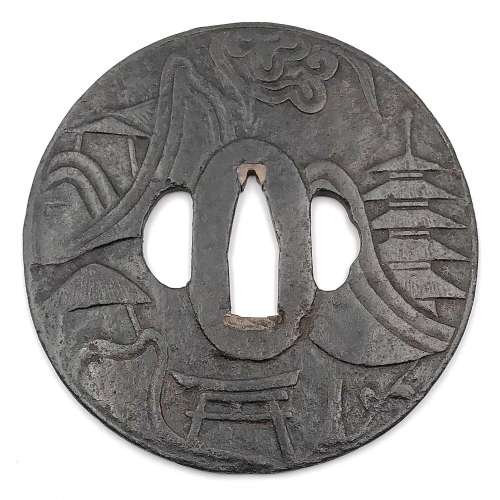
Thin iron plate of round form and black color carved in sukidashi-bori with design of rocks, waves, clouds, temple gates (torii), mountain pavilion and 5-storey pagoda on both sides, alluding to Todai-ji temple in Nara. Hitsu-ana pierced later. Very narrow very slightly raised rim. Copper sekigane.
Late Muromachi period, 16th century. Dimensions: 88.7 x 88.0 x 2.4 mm (seppa-dai), 1.8 mm (base plate).Reference: “Art of the Samurai” on page 232, №140: ”Kamakura tsuba with Sangatsu-do tower and bridge. Muromachi period, 16th century. 83 mm x 80 mm. Unsigned. Tokyo National Museum. The mountain pavilion and bridge carved in sunken relief on the iron tsuba – both part of Tōdai-ji, a temple in Nara – are detailed in fine kebori (line) engraving. As a result of the chiseling used to create the relief, the ground of the piece is relatively thin".
-
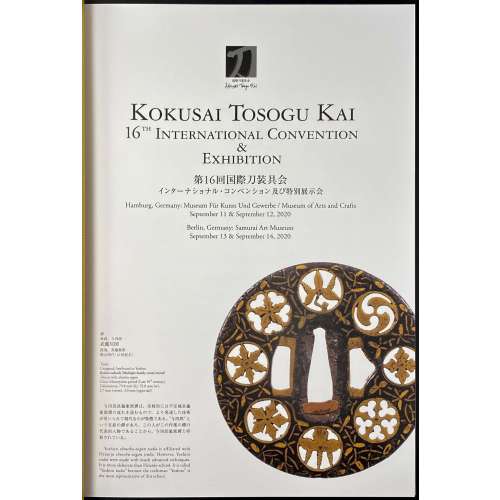 An annual publication of Kokusai Tosogu Kai / 16th International Convention & Exhibition in Hamburg, Germany: Museum Für Kunst Und Gewerbe / Museum of Arts and Crafts, September 11-12, 2020 and Berlin, Germany: Samurai Art Museum, September 13-14, 2020. Publisher: Tokyo: Kokusai Tosogu Kai, 2020. Pagination: [1-3] 4-103 [1]. Size: Medium 4to (30.3 x 21.6 cm), hardcover, original illustrated paper boards, in a slipcase. Tsuba from this collection depicted on the title page and pp. 59-60: TSU-0342.2017, TSU 0376.2018, and TSU 0379.2018. See also here.
An annual publication of Kokusai Tosogu Kai / 16th International Convention & Exhibition in Hamburg, Germany: Museum Für Kunst Und Gewerbe / Museum of Arts and Crafts, September 11-12, 2020 and Berlin, Germany: Samurai Art Museum, September 13-14, 2020. Publisher: Tokyo: Kokusai Tosogu Kai, 2020. Pagination: [1-3] 4-103 [1]. Size: Medium 4to (30.3 x 21.6 cm), hardcover, original illustrated paper boards, in a slipcase. Tsuba from this collection depicted on the title page and pp. 59-60: TSU-0342.2017, TSU 0376.2018, and TSU 0379.2018. See also here. -
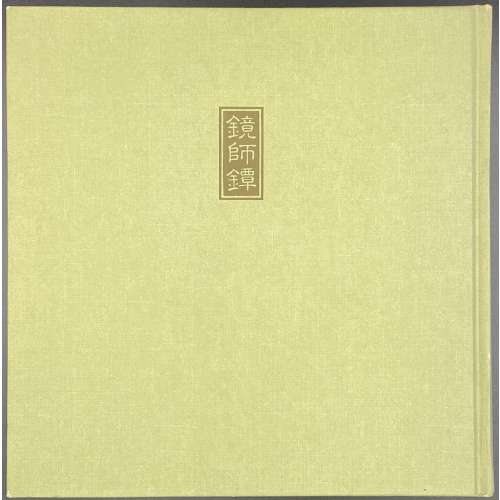 Japanese book: 24 leaves, 22 numbered plates, b/w photography reproduced photomechanically, with descriptions at the facing pages; in Japanese. Hardcover, 19 x 18.5 cm, green cloth stamped with title to front board and spine. Separate translation into English.
Japanese book: 24 leaves, 22 numbered plates, b/w photography reproduced photomechanically, with descriptions at the facing pages; in Japanese. Hardcover, 19 x 18.5 cm, green cloth stamped with title to front board and spine. Separate translation into English. -
 The Bay of Kuroto in Kazusa province [Kazusa Kuroto no ura] – an uncut fan print showing "Three women, wearing stylish cotton summer robes are shown in a skiff, admiring the view of Mount Fuji while looking back at the other passengers being helped into small boats". From the series: Views of famous places in the provinces [Shokoku meisho zue]. Ref: Sebastian Izzard. Important Japanese Prints 1830–1860 March 14–20, 2020 exhibition [LIB-2398.2020], №. 53. Not in Faulkner's Hiroshige Fan Prints, however, there are three other prints from the series, under № 95, 96 and 97 on p. 95. Artist: Utagawa Hiroshige [歌川 広重] a.k.a. Andō Hiroshige [安藤 広重] (Japanese, 1797 – 1858). Publisher: Iseya Sōemon [伊勢屋惣右衛門] (Japanese, c. 1776 – 1862). Date seal: 2/1855 Signed: Hiroshige ga. Censor's seal: aratame (certified) and date. Publisher's seal: Iseya Sōemon. Size: Aiban yoko-e uchiwa-e; 22.9 x 29.8 cm
The Bay of Kuroto in Kazusa province [Kazusa Kuroto no ura] – an uncut fan print showing "Three women, wearing stylish cotton summer robes are shown in a skiff, admiring the view of Mount Fuji while looking back at the other passengers being helped into small boats". From the series: Views of famous places in the provinces [Shokoku meisho zue]. Ref: Sebastian Izzard. Important Japanese Prints 1830–1860 March 14–20, 2020 exhibition [LIB-2398.2020], №. 53. Not in Faulkner's Hiroshige Fan Prints, however, there are three other prints from the series, under № 95, 96 and 97 on p. 95. Artist: Utagawa Hiroshige [歌川 広重] a.k.a. Andō Hiroshige [安藤 広重] (Japanese, 1797 – 1858). Publisher: Iseya Sōemon [伊勢屋惣右衛門] (Japanese, c. 1776 – 1862). Date seal: 2/1855 Signed: Hiroshige ga. Censor's seal: aratame (certified) and date. Publisher's seal: Iseya Sōemon. Size: Aiban yoko-e uchiwa-e; 22.9 x 29.8 cm


